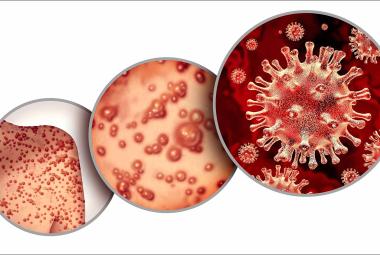This section covers OTC drugs used for pain relief, cough and cold, allergies, and sleep aids.
A typical pharmacy has shelf after shelf of medicines that can be sold without a doctor’s prescription. These are called over-the-counter (OTC) drugs. Many concerned mothers wonder about the safety of these medications while they are breastfeeding a baby. While there are many brands and varieties of drugs on the market, there is a relatively small list of active ingredients in all those products. Careful review of the product label is an essential part of responsible and safe use of these medicines. Some preparations have more than one active ingredient.
(For other ailments, see our sections on acne and GI complaints.)
Analgesic and Antipyretics
Ibuprofen: The transfer of ibuprofen in breastmilk is well studied. Very little of this medication makes it into the milk (about 0.6% of the mother’s dose). In addition, this drug is given directly to babies at much higher doses than this. Ibuprofen is the preferred analgesic in breastfeeding mothers. Do not exceed 3.2 grams/day. Common Trade Names: Advil, Nuprin, Motrin.
Acetaminophen: Acetaminophen is compatible with breastfeeding as only small amounts are secreted into breastmilk. This is given directly to infants in doses much greater than they would receive incidentally through the breastmilk. Acetaminophen is commonly included in combination products. Do not exceed 4 grams/day. Common Trade Name: Tylenol.
Naproxen: Naproxen is less well studied than the other drugs in the same class. It is secreted into the breastmilk, but apparently not in quantities that would harm an infant. However, naproxen takes longer to be eliminated from the body than the other NSAIDs and has a greater potential to damage an infant’s cardiovascular system, kidneys, and gastrointestinal tract in the event of an overdose. Short-term use (<2 weeks) of naproxen postpartum, or infrequent or occasional use should be compatible with breastfeeding. Do not exceed 1 gram/day. Common trade names: Naprox, Naprosyn, Aleve.
Aspirin: Although aspirin is secreted into breastmilk in small quantities, it has the potential to cause bleeding problems in infants and increases the risk of Reye syndrome (liver damage associated with using aspirin to treat certain viral illnesses in children). The use of “baby aspirin (81 mg per day)” is unlikely to increase the risk of these problems. Aspirin should not be the first choice for pain relief in breastfeeding mothers. However, the benefits of its unique pharmacology may outweigh the risks for women with certain conditions like rheumatic fever and after heart attacks. The decision to use aspirin should be undertaken with physician guidance. Common trade name: Bayer.
*Some headache medicines, like Excedrin, contain caffeine. See our discussion of caffeine for more information.
Cough, chest congestion
Guaifenesin: This is an expectorant used to loosen respiratory tract secretions. It does not suppress cough. The poor efficacy of expectorants in general would suggest that they do not provide enough justification for use in breastfeeding mothers. However, untoward effects to the infants have not been described. Common trade names: Robitussin, Mucinex
Dextromethorphan: This is an antitussive drug that appears to work by elevating the cough threshold in the brain. It is the safest of the antitussives and unlikely to transfer into milk. Watch breastfed infants for drowsiness or poor feeding. Common trade names: DM, Benylin, Delsym, Robitussin DM.
Allergies and sinus congestion
Diphenhydramine: Diphenhydramine is an antihistamine that is often used in cough, cold, sinus, and allergy formulations. It is also the main component in many sleep aids, including “nighttime” versions of cold medications, as well as motion sickness pills. Although the levels are low in breastmilk, this medication can cause sedation in both mother and infant and therefore is not ideal in breastfeeding mothers. There are many non-sedating antihistamines on the market, which are likely a better choice. These include cetirizine (Zyrtec), loratidine (Claritin), and fexofenadine (Allegra). There is some anecdotal evidence that diphenhydramine can suppress milk production, but this pattern is not supported by the medical literature. Common trade names: Benadryl, Tylenol PM.
Chlorpheniramine and Brompheniramine: These medicines are similar to diphenhydramine, but they have fewer studies about breastmilk safety. They are heavily sedating and not recommended. The non-sedating antihistamines are still better choices. Common trade names: Aller-Chlor, C.P.M., Chlor-Phen, Chlor-Trimeton Allergy, Teldrin HBP.
Pseudoephedrine: Pseudoephedrine is an adrenergic compound used as a nasal decongestant. It does not have antihistamine properties. It is excreted into breastmilk in low levels. Caution should be used with this product as it may reduce milk production in some mothers in late stage lactation (mothers breastfeeding infants >8 months old). Pseudoephedrine commonly appears in combination products. Common trade names: Sudafed, Claritin-D.
Phenylephrine: Phenylephrine is a decongestant that is commonly added to cold mixtures and nasal sprays for use in colds, flu, and congestion. Levels in milk have not been reported, but experiments have shown that it has poor oral absorption in infants. Common trade names: Neofrin, Neosynephrine, Vicks Sinex Nasal.
Sleeping pills
Doxylamine: This is another sedating antihistamine, similar to diphenhydramine, which is more commonly used for its sedative properties. There are no good studies about how much of this drug gets into breastmilk. In infants exposed to doxylamine, there are reports of sedation, apnea, and paradoxical CNS stimulation. Use caution with this medication. Common trade name: Unisom
Melatonin: Melatonin is a normal hormone secreted by the pineal gland in the human brain, mostly at night. It may either induce a sleep-like pattern in humans, or be the result of sleep; the evidence is not clear. It is definitely passed into human milk and some experts believe it is responsible for entraining the newborn brain to reset its circadian clock to that of the mother by communicating the time of day to the newborn. The effect of orally administered melatonin on newborns is unknown, but no adverse reactions have been reported so far.
Nasal sprays
Oxymetazoline: This decongestant comes in several formulations that last between 4 and 12 hours. There are no good studies of oxymetazoline safety during breastfeeding, however, very little of it is expected to reach the milk because it is locally administered and poorly absorbed. For this reason, oxymetazoline is a probably a better choice than oral systemic decongestants such as pseudoephedrine during breastfeeding. Oxymetazoline should only be used briefly, no more than 3 days, to avoid rebound congestion. Common trade name: Afrin.
Triamcinolone: This is the first OTC steroid nasal spray to be marketed in the United States. Triamcinolone may be used for longer periods of time without causing rebound congestion. There is virtually no risk to a breastfeeding infant when the mother uses this product nasally. Oral and topical forms (by prescription only) deserve more caution in their use. Common trade name: Nasacort.1
Nasal Saline Irrigation: Using salt water to irrigate the nose and sinuses is a practice dating back thousands of years. In modern pharmacies, saline is available in nasal sprays and nasal rinses, as well as mineral packets for home reconstitution. Sinus rinsing (aka nasal lavage) is performed using a squeeze bulb or neti pot. This practice works by mechanically removing allergens, mucous, and microorganisms from the mucosal surface. Studies have shown sinus and nasal rinsing to be highly effective in relieving symptoms of chronic rhinosinusitis2 and of limited utility in treating acute allergic problems or upper respiratory tract infections.3 Saline irrigation is the safest possible treatment for rhinosinusitis in pregnant or breastfeeding mothers. There is no drug or pathogen exposure to the baby. However, it is not advisable to perform saline irrigation directly on a baby because of the risk of aspiration. Bulb suction is the preferred method of relieving infant nasal congestion.
James Abbey, MD
InfantRisk Center
Image by Benjamin Miller
References:
1. Hale TW. Medications and mothers' milk 2014. Sixteenth ed. Amarillo, TX: Hale Pub., L.P.; 2014.
2. Achilles N, Mosges R. Nasal saline irrigations for the symptoms of acute and chronic rhinosinusitis. Current allergy and asthma reports. Apr 2013;13(2):229-235.
3. Kassel JC, King D, Spurling GK. Saline nasal irrigation for acute upper respiratory tract infections. The Cochrane database of systematic reviews. 2010(3):CD006821.







